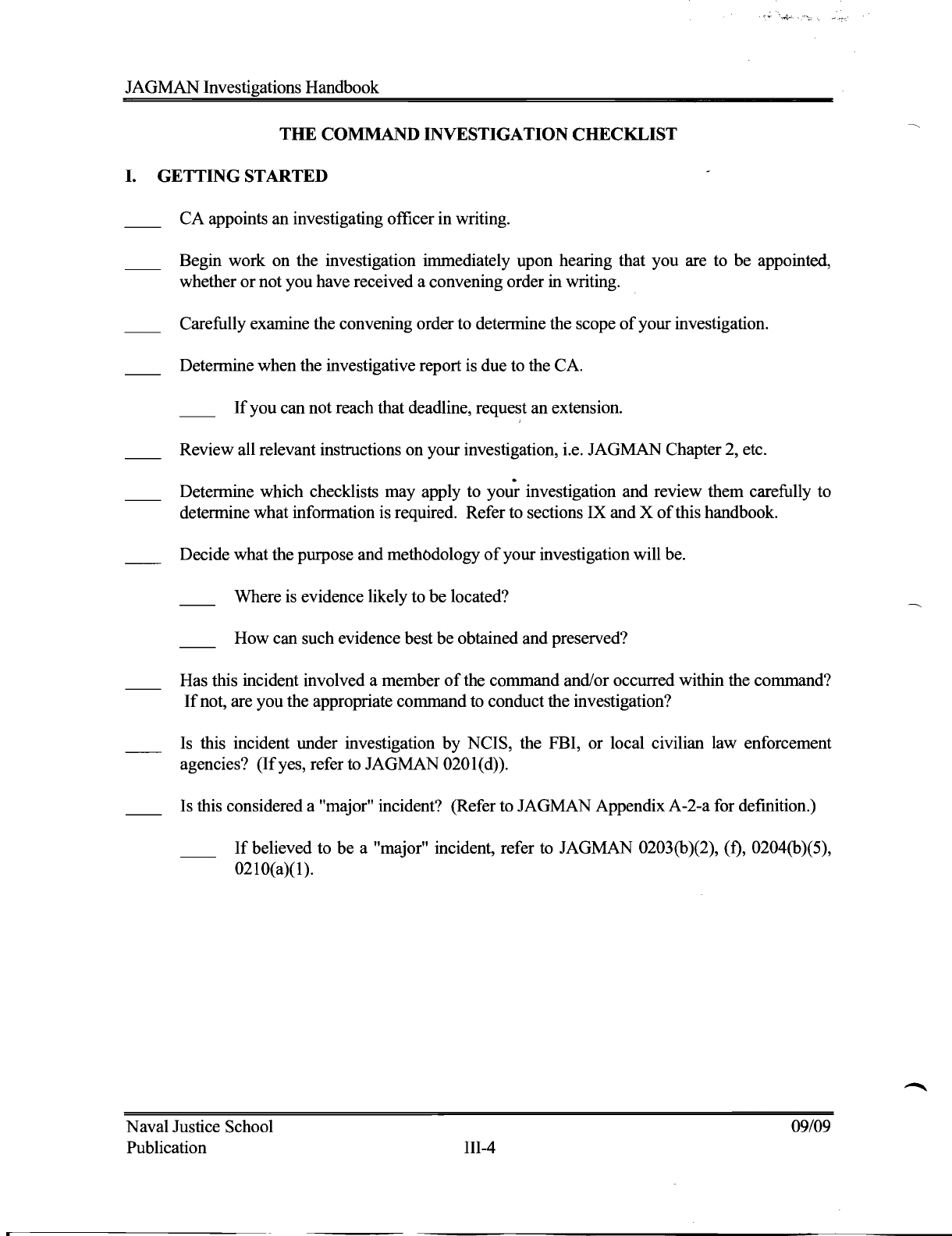
JAGMAN Investigations Handbook
THE COMMAND INVESTIGATION CHECKLIST
I. GETTINGSTARTED
CA appoints an investigating officer in writing.
Begin work on the investigation immediately upon hearing that you are to be appointed,
whether or not you have received a convening order in writing.
Carefully examine the convening order to determine the scope
of
your investigation.
Determine when the investigative report is due to the CA.
__
If
you can not reach that deadline, request an extension.
,
Review all relevant instructions on your investigation, i.e. JAGMAN Chapter 2, etc.
.
Determine which checklists may apply to your investigation and review them carefully to
determine what information is required. Refer to sections IX and X
ofthis
handbook.
Decide what the purpose and methodology
of
your investigation will be.
Where is evidence likely to be located?
How can such evidence best be obtained and preserved?
Has this incident involved a member
of
the command and/or occurred within the command?
If
not, are you the appropriate command to conduct the investigation?
Is
this incident under investigation by NCIS, the FBI, or local civilian law enforcement
agencies?
(If
yes, refer to JAGMAN 020 I(d)).
Is this considered a "major" incident? (Refer to JAGMAN Appendix A-2-a for defmition.)
If
believed to be a "major" incident, refer to JAGMAN 0203(b)(2), (t), 0204(b)(5),
0210(a)(1).
Naval Justice School
09/09
Publication
I1I-4
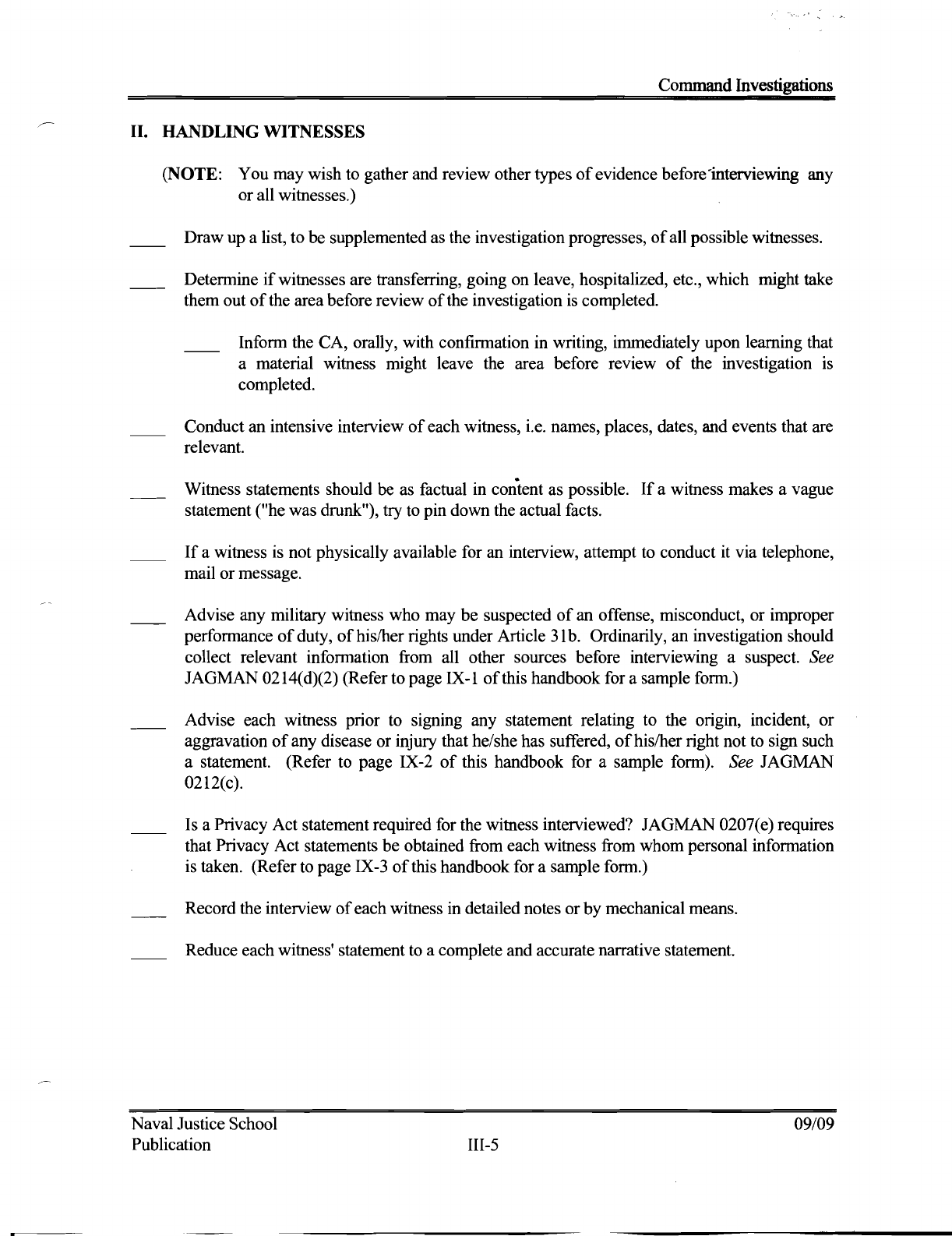
Command Investigations
II.
HANDLING
WITNESSES
(NOTE:
You
may
wish to gather and review other types
of
evidence before-interviewing any
or
all witnesses.)
Draw
up a list, to be supplemented as the investigation progresses,
of
all possible witnesses.
Detennine
if
witnesses are transferring, going on leave, hospitalized, etc., which might take
them out
of
the area before review
of
the investigation
is
completed.
Infonn
the CA, orally, with continnation in writing, immediately upon learning that
a material witness might leave the area before review
of
the investigation
is
completed.
Conduct an intensive interview
of
each witness, i.e. names, places, dates, and events that are
relevant.
Witness statements should be as factual in con·tent as possible.
If
a witness makes a vague
statement ("he was drunk"), try to pin down the actual facts.
If
a witness is not physically available for an interview, attempt to conduct it via telephone,
mail
or
message.
Advise any military witness who
may
be
suspected
of
an offense, misconduct,
or
improper
perfonnance
of
duty,
of
hislher rights under Article
31
b. Ordinarily, an investigation should
collect relevant infonnation from all other sources before interviewing a suspect.
See
JAGMAN 02l4(d)(2) (Refer to page IX-I
of
this handbook for a sample fonn.)
Advise each witness prior to signing any statement relating to the origin, incident,
or
aggravation
of
any disease
or
injury that he/she has suffered,
ofhislher
right not to sign such
a statement. (Refer to page IX-2
of
this handbook for a sample fonn). See JAGMAN
02I2(c).
Is a Privacy Act statement required for the witness interviewed?
JAGMAN
0207(e) requires
that Privacy Act statements
be
obtained from each witness from whom personal infonnation
is taken. (Refer to page IX-3
ofthis
handbook for a sample fonn.)
Record the interview
of
each witness in detailed notes
or
by
mechanical means.
Reduce each witness' statement to a complete and accurate narrative statement.
Naval Justice School
09/09
Publication III-5
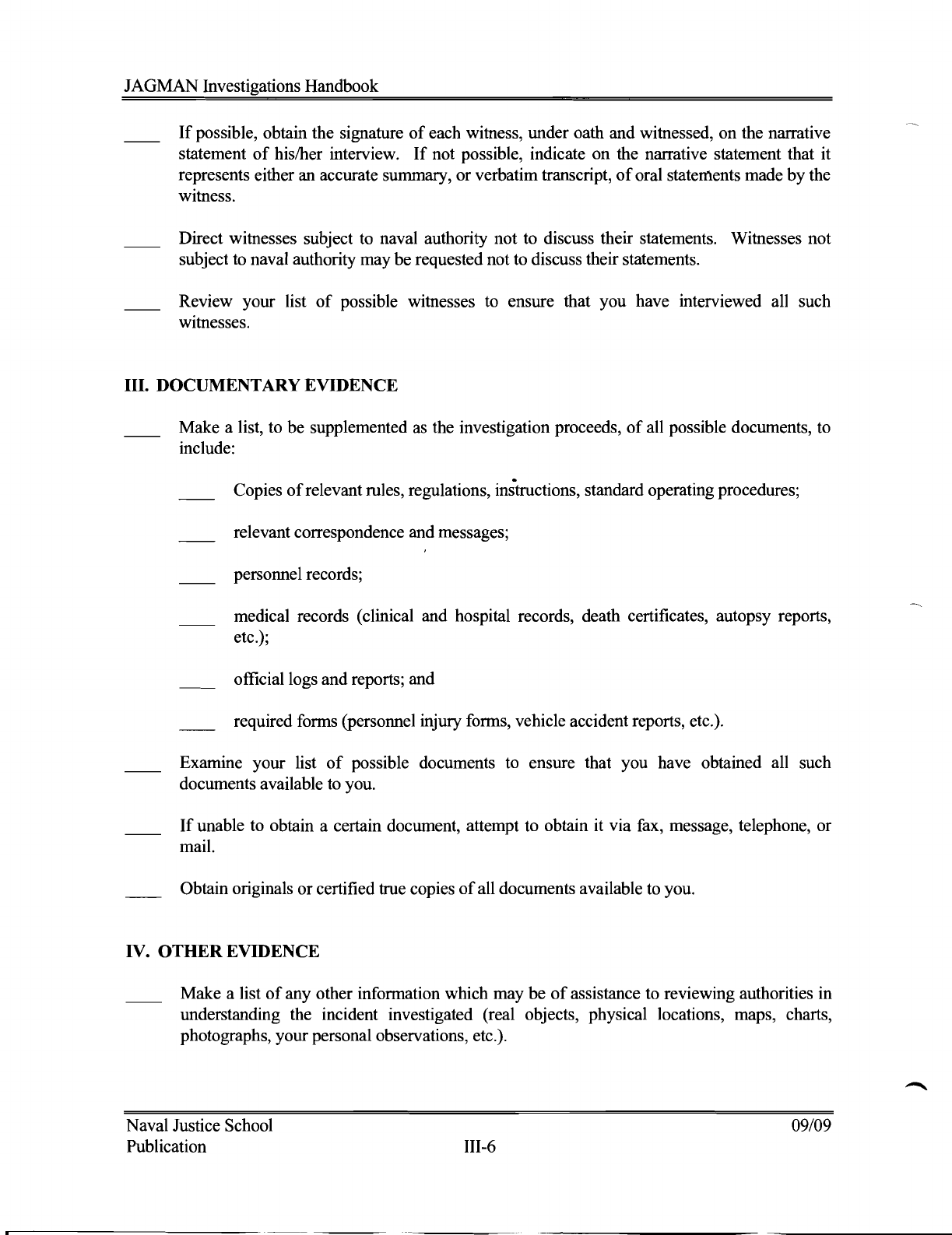
JAGMAN Investigations Handbook
If
possible, obtain the signature
of
each witness, under oath and witnessed, on the narrative
statement
of
hislher interview.
If
not possible, indicate on the narrative statement that it
represents either an accurate summary, or verbatim transcript,
of
oral statements made by the
witness.
Direct witnesses subject
to
naval authority not to discuss their statements. Witnesses not
subject
to
naval authority may be requested not to discuss their statements.
Review your list
of
possible witnesses to ensure that you have interviewed all such
witnesses.
III. DOCUMENTARY EVIDENCE
Make a list, to be supplemented
as
the investigation proceeds,
of
all possible documents, to
include:
Copies
of
relevant rules, regulations, instructions, standard operating procedures;
relevant correspondence and messages;
personnel records;
medical records (clinical and hospital records, death certificates, autopsy reports,
etc.);
official logs and reports; and
required forms (personnel injury forms, vehicle accident reports, etc.).
Examine your list
of
possible documents to ensure that you have obtained all such
documents available
to
you.
If
unable to obtain a certain document, attempt to obtain it via fax, message, telephone, or
mail.
Obtain originals or certified true copies
of
all documents available to you.
IV. OTHER EVIDENCE
Make a list
of
any other information which may be
of
assistance to reviewing authorities in
understanding the incident investigated (real objects, physical locations, maps, charts,
photographs, your personal observations, etc.).
Naval Justice School
09/09
Publication
III-6

Command Investigations
Examine your list
of
possible information to ensure that you have obtained all such
information personally available to you.
If
unable to obtain certain information, attempt to obtain
if
via fax, message, telephone, or
mail.
Attempt to reduce such information to a form, such as photographs or sketches, which can be
conveniently included
in
your investigative report.
Take all steps possible to insure that any evidence not an enclosure to the investigative report
will be kept in an identified place, safe from tampering, loss, theft, and damage, pending
review
of
the investigation.
Naval Justice School
09/09
Publication
III-7
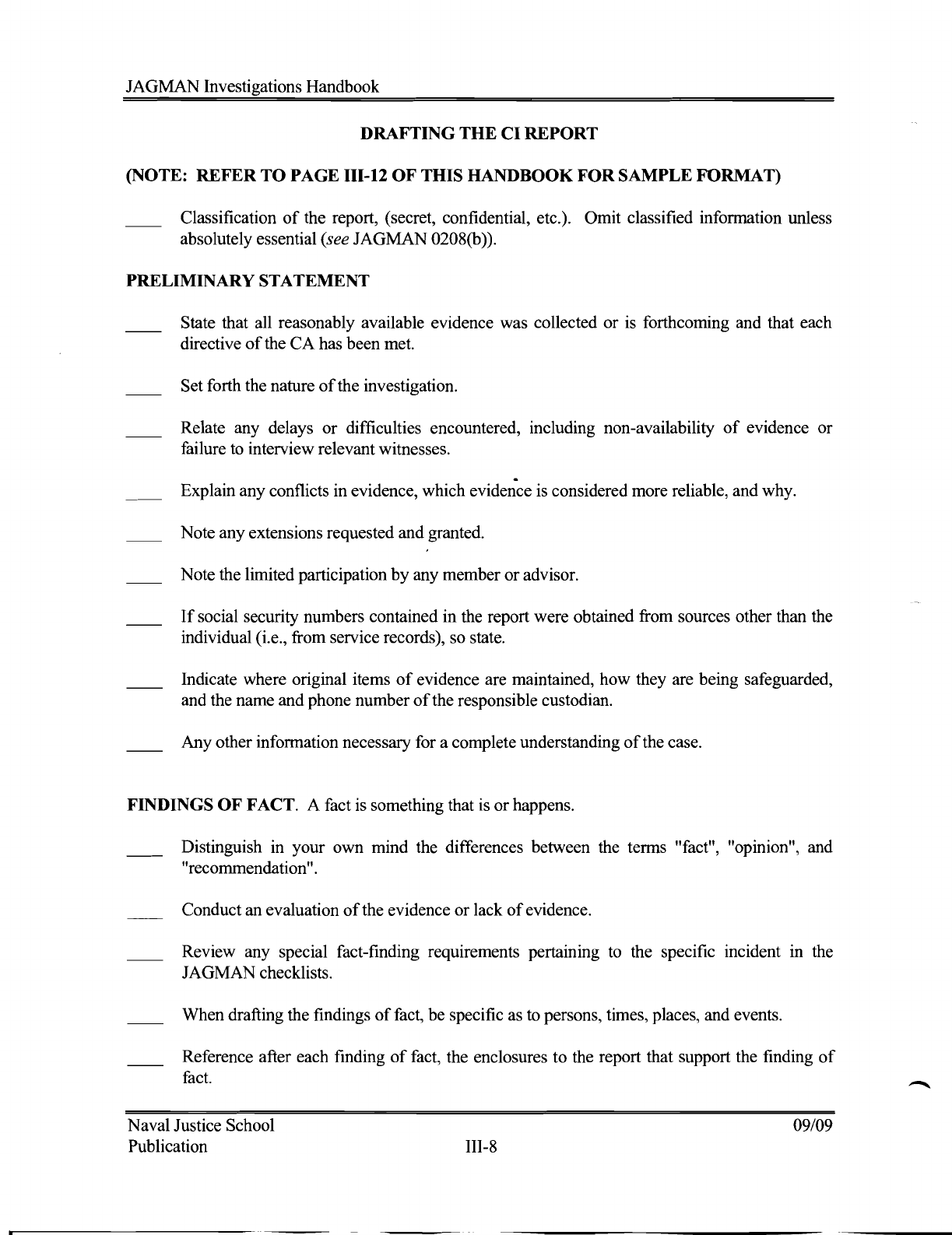
JAGMAN Investigations Handbook
DRAFTING THE CI REPORT
(NOTE: REFER TO PAGE
111-12
OF THIS HANDBOOK FOR SAMPLE FORMAT)
Classification
of
the report, (secret, confidential, etc.). Omit classified information unless
absolutely essential
(see JAGMAN 0208(b».
PRELIMINARY STATEMENT
State that all reasonably available evidence was collected or
is
forthcoming and that each
directive
of
the
CA
has been met.
Set forth the nature
ofthe
investigation.
Relate any delays or difficulties encountered, including non-availability
of
evidence or
failure
to
interview relevant witnesses.
Explain any conflicts in evidence, which evidence
is
considered more reliable, and why.
Note any extensions requested and granted.
Note the limited participation by any member or advisor.
If
social security numbers contained in the report were obtained from sources other than the
individual (i.e., from service records), so state.
Indicate where original items
of
evidence are maintained, how they are being safeguarded,
and the name and phone number
ofthe
responsible custodian.
Any other information necessary for a complete understanding
ofthe
case.
FINDINGS OF FACT. A fact
is
something that
is
or happens.
Distinguish in your own mind the differences between the terms "fact", "opinion", and
"recommendation".
Conduct an evaluation
of
the evidence or lack
of
evidence.
Review any special fact-finding requirements pertaining to the specific incident
in the
JAGMAN checklists.
When drafting the findings
of
fact, be specific as to persons, times, places, and events.
Reference after each finding
of
fact, the enclosures to the report that support the finding
of
fact.
Naval Justice School
09/09
Publication
III-8
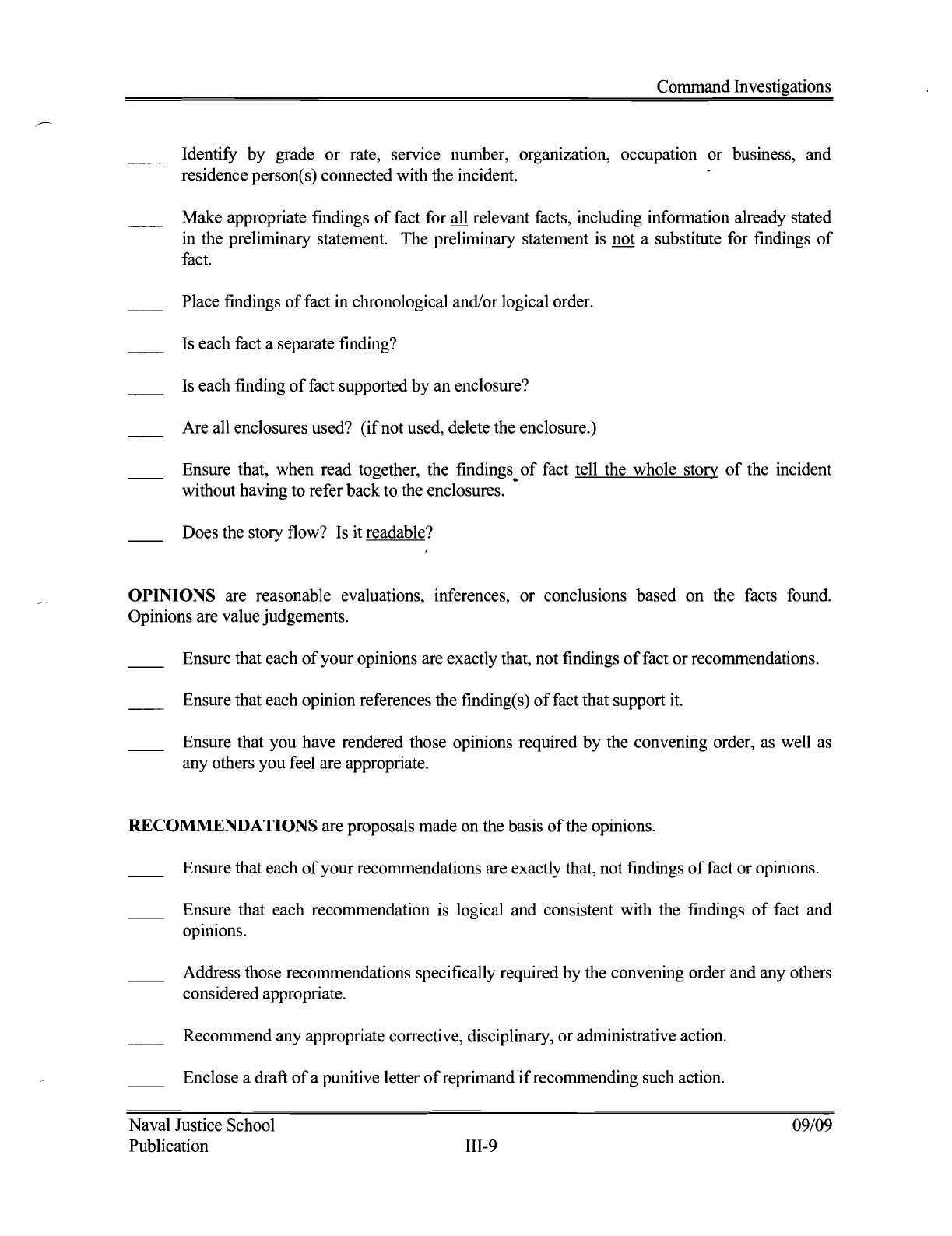
ConunandInvestigations
Identify by grade or rate, service number, organization, occupation or business, and
residence person(
s)
connected with the incident.
Make appropriate findings
of
fact for all relevant facts, including information already stated
in the preliminary statement. The preliminary statement
is
not a substitute for findings
of
fact.
Place fmdings
of
fact in chronological and/or logical order.
Is each fact a separate finding?
Is
each finding
of
fact supported by an enclosure?
Are all enclosures used?
(if
not used, delete the enclosure.)
Ensure that, when read together, the findings
of
fact tell the whole story
of
the incident
without having to refer back to the enclosures
.•
Does the story flow? Is
it
readable?
OPINIONS are reasonable evaluations, inferences, or conclusions based on the facts found.
Opinions are value judgements.
Ensure that each
of
your opinions are exactly that, not findings
of
fact or reconunendations.
Ensure that each opinion references the finding(s)
offact
that support
it.
Ensure that you have rendered those opinions required by the convening order, as well as
any others you feel are appropriate.
RECOMMENDATIONS are proposals made on the basis
of
the opinions.
Ensure that each
of
your reconunendations are exactly that, not findings
of
fact or opinions.
Ensure that each reconunendation is logical and consistent with the fmdings
of
fact and
opmlOns.
Address those reconunendations specifically required by the convening order and any others
considered appropriate.
Reconunend any appropriate corrective, disciplinary, or administrative action.
Enclose a draft
of
a punitive letter
of
reprimand
if
reconunending such action.
Naval Justice School
09109
Publication
III-9

JAGMAN Investigations Handbook
Draft and send, under separate cover, a non-punitive letter
of
caution
if
recommending such
action.
SIGNING
Sign your report.
ENCLOSURES
Convening order.
All evidence in logical order.
Is each statement, affidavit, transcript
or
sUffi!llary
of
testimony, photograph, map, chart,
document, or other exhibit, a separate enclosure?
Are any reproduced documents certified to be true copies?
Have you complied with the special marking requirements applicable to
photographs?
See JAGMAN, 0207(b)(4) and 0208(g)(1).
Are enclosures listed in the order in which they are cited in the body
of
the investigation?
Ensure that you do not have inappropriate material in the investigation: NCIS reports
of
investigations; aircraft mishap reports; Inspector General reports; polygraph examinations;
medical quality assurance investigations.
CONCLUDING ACTION
Have you stretched your imagination to the utmost in gathering and recording all possible
information on the incident investigated?
Have you checked and double-checked to ensure that your findings
of
fact, opinions,
recommendations, and enclosures are in proper order?
Have you carefully proofread your Investigative Report to guard against embarrassing
clerical errors?
Have you signed your Investigative Report?
Naval Justice School
09/09
Publication
III-lO
